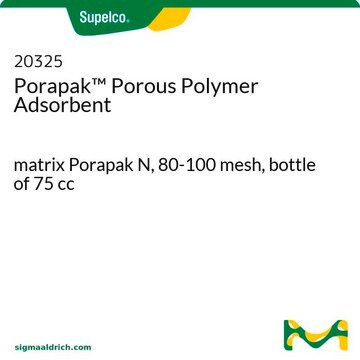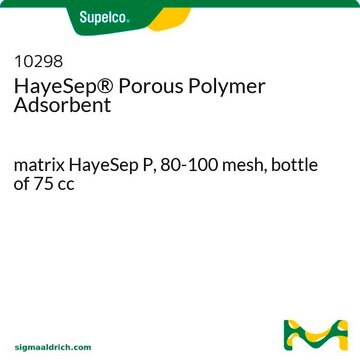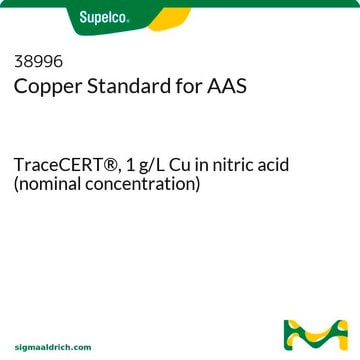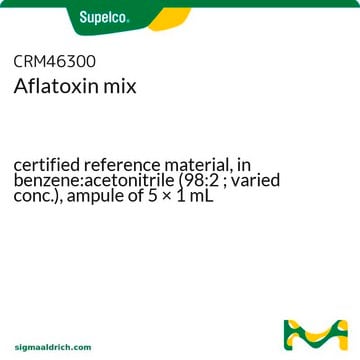10307
HayeSep® Porous Polymer Adsorbent
matrix HayeSep S, 80-100 mesh, bottle of 75 cc
Sign Into View Organizational & Contract Pricing
All Photos(1)
About This Item
UNSPSC Code:
23201100
eCl@ss:
32119290
Recommended Products
form
solid
packaging
bottle of 75 cc
manufacturer/tradename
Hayes Separation Inc
parameter
250 °C temp. limit
technique(s)
gas chromatography (GC): suitable
surface area
~583 m2/g
matrix
HayeSep S
particle size
80-100 mesh
density
~0.33 g/mL (free fall density)
Looking for similar products? Visit Product Comparison Guide
General description
Porous polymers are the most suitable adsorbent for applications based on the analysis of gases, acids, amines, organics of low carbon number and water. They are best suited for gas chromatography and are basically copolymers of polydivinylbenzene (DVB) which are very porous in nature ranging from mesoporous to microporous. HayeSep® has a high surface area owing to its micropores thereby making it a suitable candidate for separation of gases and volatile organic compounds (VOCs). Furthermore they are relatively inert and exhibit hydrophobicity.
HayeSep porous polymers, considered second generation materials, are consistent batch-to-batch, with minimal shrinkage and monomer bleed.
For more information about any of our adsorbents, please visit sigma-aldrich.com/adsorbents
For more information about any of our adsorbents, please visit sigma-aldrich.com/adsorbents
Application
HayeSep S was used for the analysis of hydrocarbons to check the microbial production of propane and ethane in the deep marine sediments. It was also used for methyl acetate hydrogenolysis activity experiments which were performed in a gas flow set-up to study the relation between reduction temperature and activity in copper catalysed ester hydrogenolysis and methanol synthesis.
Legal Information
HayeSep is a registered trademark of Hayes Separation Inc.
Storage Class
13 - Non Combustible Solids
wgk_germany
WGK 3
flash_point_f
Not applicable
flash_point_c
Not applicable
ppe
Eyeshields, Gloves, type N95 (US)
Choose from one of the most recent versions:
Certificates of Analysis (COA)
Lot/Batch Number
Sorry, we don't have COAs for this product available online at this time.
If you need assistance, please contact Customer Support.
Already Own This Product?
Find documentation for the products that you have recently purchased in the Document Library.
The relation between reduction temperature and activity in copper catalysed ester hydrogenolysis and methanol synthesis.
Brands DS, et al.
Catalysis Letters, 36 (3), 175-181 (1996)
Kai-Uwe Hinrichs et al.
Proceedings of the National Academy of Sciences of the United States of America, 103(40), 14684-14689 (2006-09-23)
Concentrations and isotopic compositions of ethane and propane in cold, deeply buried sediments from the southeastern Pacific are best explained by microbial production of these gases in situ. Reduction of acetate to ethane provides one feasible mechanism. Propane is enriched
Trace Analysis of Specialty and Electronic Gases.
Geiger W.M and Raynor M.W. et al.
Science, 256-257 (2013)
Columns for Gas Chromatography: Performance and Selection.
Grob RL and Barry EF. et al.
Science, 22-23 (2007)
Gas Chromatography.
Poole C. et al.
Science, 127-130 (2012)
Our team of scientists has experience in all areas of research including Life Science, Material Science, Chemical Synthesis, Chromatography, Analytical and many others.
Contact Technical Service








